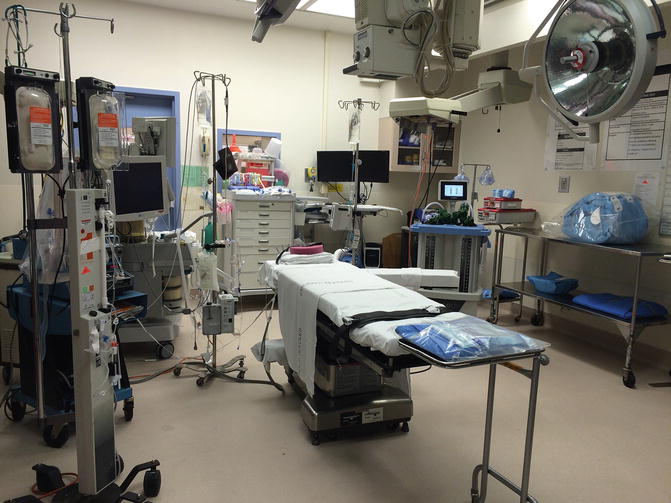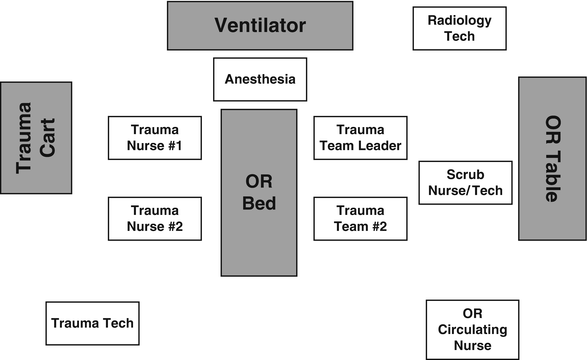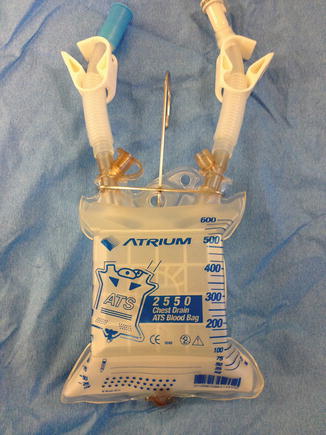Penetrating trauma with hypotension (systolic blood pressure <90 mmHg)
Witnessed traumatic cardiac arrest
Hypotension unresponsive to prehospital fluid challenge
Major external hemorrhage/traumatic amputation of a limb
Direct injury to neck with airway compromise
Initial Assessment in an Operating Room Resuscitation
Once the decision is made for triage directly to the operating room, personnel are alerted to report to the designated trauma operating suite (Fig. 10.1). The trauma team responds and functions as the team leader, responsible for directing the activity and tasks of all other team members in the room (Fig. 10.2). During operating room resuscitation, the trauma team leader is positioned on the left side near the head of the bed in order to conduct the primary survey but allow anesthesia access to the airway. The team leader also directs the team members to prepare for any indicated procedures during the initial evaluation including control of external bleeding and the placement of central lines or chest tubes. While positioned at the head of the bed, the trauma team leader can also evaluate the need for a controlled airway, and can direct the anesthesia team to attempt orotracheal intubation when indicated. Trauma resuscitation nurses are present to record vital sign and exam findings, in addition to obtaining peripheral intravenous access, and administering medications under the direction of the trauma team leader. The anesthesia team reports to the head of the bed where they prepare for possible orotracheal intubation, if needed. The operating room nurses and technicians respond and prepare to open sterile laparotomy, thoracotomy, or major vascular trays when directed to do so by the trauma team leader. Radiology technicians also report to the operating room to obtain plain film radiographs during the initial evaluation.



Fig. 10.1
Dedicated operating room resuscitation suite

Fig. 10.2
Operating room resuscitation personnel
The prehospital providers deliver the patient directly to the operating room and transfer the patient to the operating room table after giving a brief organized report detailing the Mechanism of injury, obvious Injuries, the patient’s Vital signs, and any Treatments provided (MIVT). The trauma team leader then begins the primary and secondary survey based on ATLS protocol.
Diagnosis and Treatment of Shock in the Operating Room
Hypovolemic shock due to hemorrhage is the most common cause of shock and can occur due to bleeding into the chest, abdomen, pelvis/retroperitoneum, into the extremities, or due to blood lost externally. Lack of response to fluid or blood product resuscitation indicates significant ongoing hemorrhage and necessitates immediate measures to identify and control the source of bleeding. Just as in the trauma bay, sources of external bleeding should be controlled with direct pressure or tourniquets prior to operative intervention aimed at proximal and distal control of any vascular injury. Bleeding into the chest can be diagnosed with a chest radiograph obtained in the operating suite and can be treated, and blood loss quantified, with chest tube placement. In-line or other types of devices should be arranged to collect shed blood after chest tube placement for autotransfusion (Fig. 10.3). Massive hemothorax can be addressed with immediate conversion to thoracotomy in the operating room. All patients with penetrating trauma to the chest, particularly those with injuries in the zone denoted by the clavicles superiorly, costal margin inferiorly, and bilateral mid-clavicular lines should be suspected of cardiac injury and evaluated with pericardial ultrasound and/or subxiphoid window. Findings of pericardial fluid or patients with hemodynamic instability and high index of suspicion for cardiac injury should undergo immediate midline sternotomy. Those in extremis or who undergo cardiac arrest should undergo immediate resuscitative thoracotomy if they are a victim of penetrating trauma with <15 min of prehospital CPR, or <10 min of prehospital CPR with a secured airway for a blunt mechanism of injury [2]. At UCSD most, if not all, resuscitative thoracotomies are performed in the Operating Room (OR), as those patients requiring the procedure do not stop in the trauma bay or in the Emergency Department (ED), and are transported from the scene directly to the OR. The advantages of performing the procedure in the OR compared to the ED are obvious, including but not limited to more available equipment options, better lighting, general anesthesia and airway control, absence of chaos and excessive noise, as well as improved sterility.


Fig. 10.3
Autotransfusion device (Chest Drain, ATS Blood Bag, Atrium, Merrimack, NH)
Patients with peritonitis should undergo laparotomy regardless of hemodynamic status which can occur promptly during an OR resuscitation as the OR staff is present and surgical instruments immediately available. Patients without peritonitis can be evaluated using a Focused Assessment with Sonography for Trauma (FAST) while in the OR, or diagnostic peritoneal aspiration/lavage (DPA/DPL). A positive FAST or DPA/DPL, in a hypotensive patient is another indication for immediate laparotomy which should be rapidly mobilized in the OR setting. Resuscitation in the OR does not mandate operative intervention. Patients evaluated and resuscitated in the OR who do not require operative intervention can be transported to the computed tomography (CT) scanner for further imaging, or to the intensive care unit for further resuscitation based on the injuries diagnosed.

Full access? Get Clinical Tree








